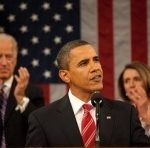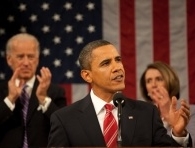
Education is one of the few areas of the federal budget that would not see a spending freeze, if President Barack Obama gets his way this year.
In his State of the Union speech on Jan. 27, Obama said his administration will work with Congress to expand school improvements across the country, saying the success of children cannot depend on where they live.
As he prepares to ask Congress for billions of dollars in new spending for education, the president said the nation’s students need to be inspired to succeed in math and science, and that failing schools need to be turned around.
Obama also called on Congress to finish work on a measure to revitalize community colleges. And he called for a $10,000 tax credit to families for four years of college, as well as an increase in Pell Grants.
“In the 21st century, one of the best anti-poverty programs is a world-class education,” Obama said.
He said college students should only have to devote 10 percent of their post-college income to repaying student loans.
“And let’s tell another one million students that when they graduate, … all of their debt will be forgiven after 20 years—and forgiven after 10 years if they choose a career in public service, because in the United States of America, no one should go broke because they chose to go to college,” he added.
Obama will ask Congress to boost federal spending on education by as much as $4 billion in the coming 2011 budget year, Education Secretary Arne Duncan said earlier in the day.
Of that total, $3 billion is slated for elementary and secondary education programs ranging from teacher quality to student safety.
The sum also includes another $1.35 billion for Obama’s “Race to the Top” competitive grant program, which was created last year using $4.35 billion from the economic stimulus bill. States must compete for a share of the money and, for some, that means changing their education laws and striking deals with teacher unions to bring their systems in line with Obama’s vision of education reform.
“This year, we have broken through the stalemate between left and right by launching a national competition to improve our schools,” Obama said in his State of the Union address. “The idea here is simple: Instead of rewarding failure, we only reward success.”
Obama sees linking student test scores to teacher performance and creating charter schools as solutions to the problems plaguing public education. Charter schools are funded with public money but operate independently of local school boards. These ideas are controversial, however, and 10 states chose not to apply for Race to the Top funding as a result.
The first round of Race to the Top awards is expected to be announced in April.
With the additional $1.35 billion, states not awarded money in the first round would get another chance to compete. Local school districts also would be allowed to apply.
The rest of the money Obama seeks for K-12 education would become available after Congress overhauls the No Child Left Behind (NCLB) education law, which is due for a rewrite. Duncan said he hopes that process will be completed by August.
The request for $4 billion would increase federal education spending by about 6 percent.
The Education Department also wants to eliminate six programs, deeming them duplicative or ineffective. The agency would consolidate 38 other programs into 11 programs to eliminate bureaucracy and red tape. Duncan said the details about which programs these proposals would include will be available next week, when the president sends his 2011 budget plan to Congress.
Duncan said Obama’s decision to boost education spending, at the same time he is calling for a freeze on other federal spending, shows how important the issue is to the president.
“Given how tough the economy is now, having a 6 percent increase at this point is extraordinary,” Duncan said. “You’re not seeing that happen anyplace else.”
Education groups said they were thankful the president is making education a key priority in his 2011 budget, and they look forward to working with Congress on reauthorizing NCLB.
“With the possible exception of Wall Street, nowhere in America have people been unaffected by our nation’s economic crisis,” said Randi Weingarten, president of the American Federation of Teachers, in a statement.
“In these tough times, we appreciate that President Obama is trying to shield children from budget cuts that affect their schools. He understands that kids don’t get a second chance to receive a good education and that our country’s future depends on the quality of education we provide for our children.”
Her statement, issued before Obama’s State of the Union speech, did not address the proposed increase in Race to the Top funding or the use of test scores as an indicator of teacher quality. But in a Jan. 12 speech at the National Press Club, Weingarten said a comprehensive and robust evaluation system that relies on much more than just test scores is the necessary predicate for developing high-quality teachers, and for a fair, expedient process to remove ineffective teachers from the classroom.
“For too long and too often, teacher evaluation—in both design and implementation—has failed to achieve what must be our goal: continuously improving and informing teaching so as to better educate all students,” Weingarten said in her speech. “We need to put … time and effort into developing and evaluating teachers. And we need to ensure that the women and men who teach our children are participants in every stage of the process. That’s what we mean when we say do these things ‘with us, not to us.’”
Bob Wise, president of the Alliance for Excellent Education and former governor of West Virginia, had this to say after the president’s speech:
“By linking education to the economy, President Obama made clear that diplomas mean dollars. … Better educational outcomes mean better economic outcomes. That’s certainly true for the individual, but, as [the president] made clear, it’s also true for the nation.”
He added: “The research backs him up. According to an Alliance for Excellent Education report, cutting the dropout rate in half in the nation’s 50 largest cities would create 30,000 new jobs, increase home sales by $10.5 billion, and boost economic growth in these areas by $5.3 billion.”
With NCLB nearly ten years old, Wise said, Obama “made the right call to action—this year, pass [a new version of the law] without delay. A generation of students and skilled workers depend[s] on it.”
But the new version must do more to strengthen high schools, Wise implored.
“NCLB has driven gains in the early grades and highlighted large achievement gaps between students, but has largely ignored high school students,” he said. “In 2010, its time for a reauthorized [education law] that strategically addresses the dropout crisis and begins turning the more than one million dropouts a year into high school graduates who are ready for college and careers.”
Obama is expected to send his budget proposal to Capitol Hill on Feb. 2.
Links:
American Federation of Teachers
Alliance for Excellent Education
- ‘Buyer’s remorse’ dogging Common Core rollout - October 30, 2014
- Calif. law targets social media monitoring of students - October 2, 2014
- Elementary world language instruction - September 25, 2014



Comments are closed.